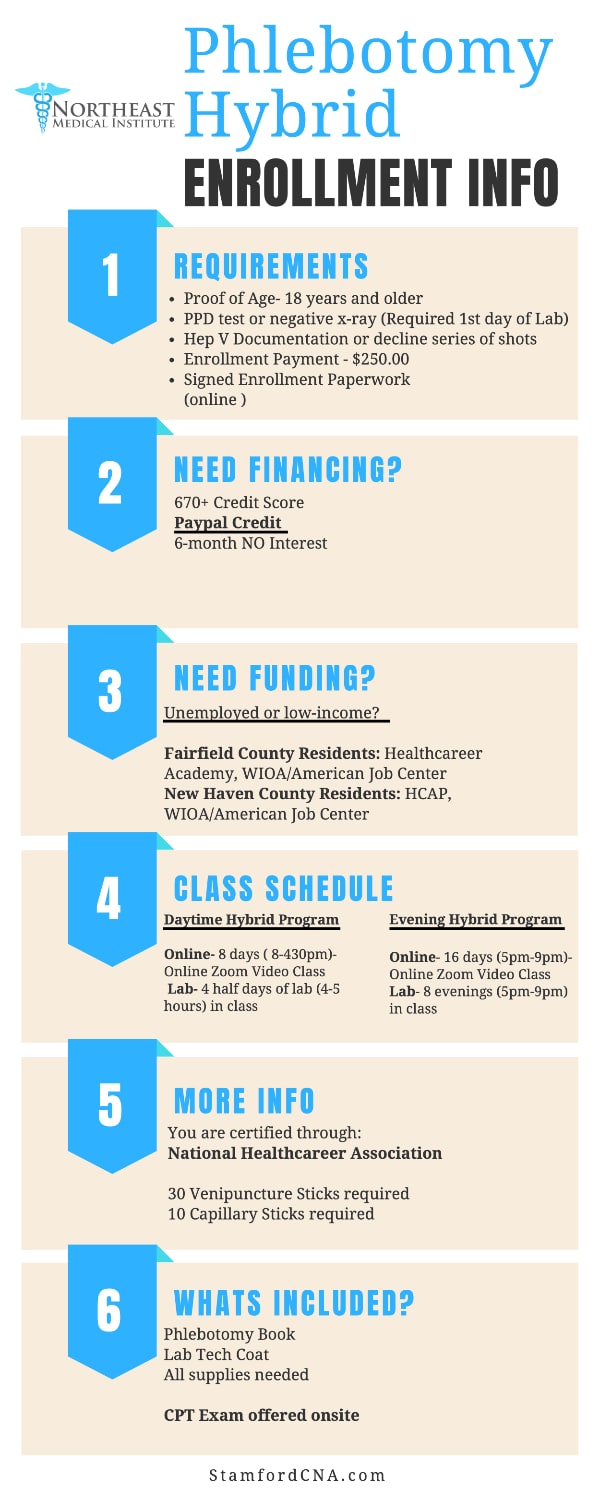Some Ideas on Northeast Medical Institute - New Haven Campus Phlebotomy Course & Cna Class You Need To Know
Table of ContentsGetting The Northeast Medical Institute - New Haven Campus Phlebotomy Course & Cna Class To Work4 Simple Techniques For Northeast Medical Institute - New Haven Campus Phlebotomy Course & Cna ClassIndicators on Northeast Medical Institute - New Haven Campus Phlebotomy Course & Cna Class You Should KnowThe Best Guide To Northeast Medical Institute - New Haven Campus Phlebotomy Course & Cna ClassNortheast Medical Institute - New Haven Campus Phlebotomy Course & Cna Class Can Be Fun For EveryoneNortheast Medical Institute - New Haven Campus Phlebotomy Course & Cna Class - Questions
The use of such devices need to be come with by other infection prevention and control practices, and training in their usage. Not all safety and security gadgets are relevant to phlebotomy. Prior to picking a safety-engineered gadget, users need to completely examine available tools to identify their appropriate usage, compatibility with existing phlebotomy methods, and efficacy in shielding staff and patients (12, 33).For setups with low sources, expense is a driving element in purchase of safety-engineered tools - PCT Classes. Where safety-engineered gadgets are not available, proficient use a needle and syringe is acceptable. Unexpected direct exposure and certain information regarding an incident must be tape-recorded in a register. Assistance solutions ought to be advertised for those that go through unintended direct exposure.
One of the important markers of high quality of care in phlebotomy is the involvement and teamwork of the person; this is mutually advantageous to both the health and wellness employee and the person. Clear details either composed or spoken need to be available to each individual who undertakes phlebotomy. Annex F provides sample text for discussing the blood-sampling treatment to a person. labelling); transportation conditions; analysis of outcomes for medical management. In an outpatient department or facility, provide a dedicated phlebotomy workstation containing: a clean surface area with 2 chairs (one for the phlebotomist and the other for the client); a hand clean container with soap, running water and paper towels; alcohol hand rub. In the blood-sampling area for an outpatient department or clinic, give a comfy reclining couch with an arm remainder.
The Ultimate Guide To Northeast Medical Institute - New Haven Campus Phlebotomy Course & Cna Class
Ensure that the indications for blood sampling are plainly specified, either in a written method or in documented guidelines (e.g. in a research laboratory form). In all times, comply with the approaches for infection avoidance and control noted in Table 2.2. Infection prevention and control techniques. Collect all the tools needed for the procedure and location it within secure and easy reach on a tray or trolley, making certain that all the items are plainly noticeable.
Present on your own to the individual, and ask the person to state their full name. Examine that the research laboratory kind matches the patient's identity (i.e. match the person's information with the research laboratory type, to guarantee accurate recognition).
Make the patient comfy in a supine setting (if feasible). The client has a right to refuse an examination at any time prior to the blood sampling, so it is vital to make sure that the client has actually comprehended the treatment - CNA Classes.
The Facts About Northeast Medical Institute - New Haven Campus Phlebotomy Course & Cna Class Uncovered
Expand the patient's arm and examine the antecubital fossa or forearm. Find a capillary of an excellent dimension that is noticeable, straight and clear.
DO NOT find here put the needle where blood vessels are diverting, due to the fact that this raises the chance of a haematoma. The blood vessel needs to be visible without applying the tourniquet. Situating the capillary will certainly assist in establishing the appropriate dimension of needle. Use the tourniquet about 45 finger widths above the venepuncture website and re-examine the vein.
Samplings from main lines bring a threat of contamination or erroneous research laboratory test outcomes. It is appropriate, but not excellent, to draw blood samplings when first introducing an in-dwelling venous gadget, prior to connecting the cannula to the intravenous fluids.
Northeast Medical Institute - New Haven Campus Phlebotomy Course & Cna Class Things To Know Before You Buy
Failure to allow enough contact time increases the threat of contamination. DO NOT touch the cleansed website; in certain, DO NOT put a finger over the capillary to direct the shaft of the subjected needle.
Ask the client to form a fist so the blood vessels are extra prominent. Get in the blood vessel swiftly at a 30 level angle or less, and remain to present the needle along the blood vessel at the most convenient angle of entrance - PCT Classes. When adequate blood has been collected, launch the tourniquet BEFORE withdrawing the needle
7 Easy Facts About Northeast Medical Institute - New Haven Campus Phlebotomy Course & Cna Class Shown
Withdraw the needle carefully and use gentle pressure to the site with a tidy gauze or completely dry cotton-wool ball. Ask the person to hold the gauze or cotton wool in position, with the arm extended and raised. Ask the individual NOT to flex the arm, since doing so creates a haematoma.

8 Easy Facts About Northeast Medical Institute - New Haven Campus Phlebotomy Course & Cna Class Explained
Do not press the syringe plunger because additional pressure increases the threat of haemolysis. Where feasible, keep the tubes in a rack and move the rack towards you. Inject downwards right into the appropriate coloured stopper. DO NOT remove the stopper because it will launch the vacuum cleaner. If the example tube does not have a rubber stopper, infuse very slowly into the tube as minimizing the pressure and rate made use of to transfer the specimen decreases the risk of haemolysis.
